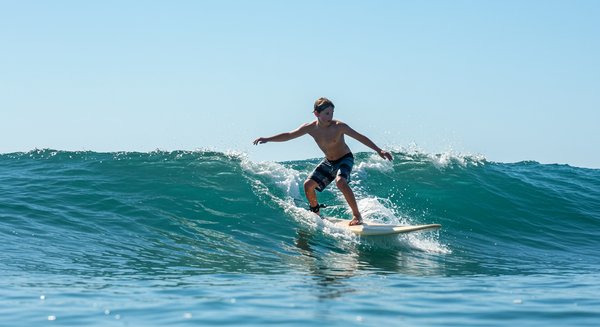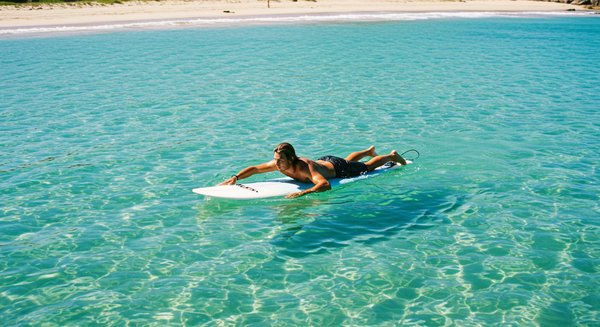Lesson
Introduction to Surf Safety & Basics
Welcome to the exciting world of surfing! Before you grab a board and paddle out, it's crucial to understand the fundamentals of surf safety and basic techniques. This lesson will cover ocean awareness, surf etiquette, board handling, safe entry and exit strategies, and the prone paddling technique.

Ocean Awareness
The ocean is a powerful force, and understanding its dynamics is paramount to your safety. Observe the conditions before you even think about entering the water.
- Wave Size and Type: Are the waves small and gentle, or large and powerful? Are they breaking cleanly, or are they messy and unpredictable?
- Tides: High and low tides influence wave shape and strength. Check the tide charts before heading out. Strong currents often occur during tide changes.
- Currents: Identify any rips or currents. These are powerful flows of water moving away from the shore, and can quickly pull you out to sea. Look for areas where the waves aren't breaking as consistently, or where the water appears discolored.
- Weather: Be aware of the weather forecast. Wind can affect wave conditions, and storms can create dangerous situations.
- Marine Life: Be aware of local marine life. Enquire at surf shops for any known dangers.
Surf Etiquette
Surf etiquette ensures everyone has a safe and enjoyable experience. Follow these basic rules:
- Right of Way: The surfer closest to the peak (the highest part of the breaking wave) has the right of way. Do not "drop in" on someone already riding the wave.
- Paddle Wide: When paddling back out, paddle wide around the breaking waves to avoid getting in the way of surfers riding them.
- Communicate: If you accidentally drop in on someone, apologize. If you're paddling out and see someone about to drop in on you, shout a warning.
- Respect Localism: Be respectful of local surfers. They know the break best and may have been surfing there for years.
- Don't Snake: "Snaking" is paddling around someone to get closer to the peak and steal their wave. It's considered very rude.
Board Handling on the Beach
Your surfboard is your tool, and it's important to handle it with care both in and out of the water. Here's how to handle your board on the beach:
- Carry it Safely: Carry your board under your arm, nose pointing slightly downwards. Be mindful of other people around you.
- Protect the Fins: Avoid dragging the fins on the sand, as this can damage them.
- Leash Awareness: Ensure your leash is securely attached to your ankle before entering the water.
- Never Leave it Unattended: A runaway board can be dangerous to others, especially in windy conditions.
Safe Entry and Exit
Entering and exiting the water safely is critical. Here's how:
- Observe the Break: Before entering, watch the waves for a few minutes to identify the best entry point – usually a calmer area with fewer breaking waves.
- Hold On Tight: As you enter, hold onto your board firmly to prevent it from being washed away.
- Duck Dive or Turtle Roll: When a wave approaches, either duck dive under it (for smaller waves) or turtle roll (for larger waves). A turtle roll involves flipping the board over, holding onto the rails, and letting the wave pass over you.
- Exit Strategically: When exiting, choose a calmer area away from breaking waves. Use your board as a shield against incoming waves.
Prone Paddling Technique
Prone paddling is the foundation of surfing. Mastering this technique will make it easier to catch waves and conserve energy.
- Positioning: Lie prone (face down) on the board, with your body centered. Your chest should be slightly off the board to allow for a better paddle stroke.
- Paddle Stroke: Extend your arms forward, reaching as far as possible. Cup your hands slightly and pull them through the water, keeping your elbows relatively straight.
- Recovery: Lift your arms out of the water and swing them forward for the next stroke.
- Body Rotation: Use your core muscles to rotate your body slightly with each stroke. This will increase your power and efficiency.
- Look Ahead: Keep your head up and look towards your target. This helps with balance and direction.

Understanding Rip Currents
Rip currents are strong, narrow currents that flow away from the shore. They are a major hazard for surfers and swimmers. Recognizing and escaping a rip current is vital for safety.
How to Identify a Rip Current:
- A channel of churning, choppy water.
- An area with a notable difference in water color.
- A line of foam or debris moving steadily seaward.
- A break in the incoming wave pattern.
How to Escape a Rip Current:
- Stay Calm: Panicking will only exhaust you.
- Don't Fight It: Don't try to swim directly back to shore against the current.
- Swim Parallel: Swim parallel to the shore until you are out of the rip current.
- Signal for Help: Once out of the rip, swim towards shore at an angle. If you are unable to swim out of the rip, float and signal for help.
Importance of a Surf Leash
A surf leash is a cord that connects your surfboard to your ankle. It's an essential safety device that prevents your board from drifting away after a wipeout. Here's why it's so important:
- Keeps Your Board Close: Prevents you from having to swim long distances to retrieve your board.
- Protects Others: Prevents your board from becoming a hazard to other surfers and swimmers.
- Reduces Fatigue: Conserves energy by eliminating the need to constantly chase after your board.
Leash Maintenance:
- Rinse your leash with fresh water after each surf session to prevent corrosion.
- Check your leash regularly for signs of wear and tear, such as fraying or cracks.
- Replace your leash if it is damaged or weakened.
First Aid Basics for Surfers
While surfing is generally safe, minor injuries can occur. Knowing basic first aid can help you handle these situations effectively.
- Cuts and Scrapes: Clean the wound thoroughly with soap and water. Apply antiseptic and a bandage.
- Sunburn: Apply sunscreen liberally before and during your surf session. If you get sunburned, apply aloe vera or other soothing lotion.
- Muscle Cramps: Stretch and massage the affected muscle. Drink plenty of fluids to stay hydrated.
- Jellyfish Stings: Rinse the affected area with seawater (not fresh water). Remove any tentacles with tweezers. Apply vinegar or a sting relief product.
Choosing the Right Surfboard for Beginners
Selecting the right surfboard is crucial for a beginner. A larger, more stable board will make it easier to paddle, catch waves, and stand up.
- Longboard: Longboards (9 feet or longer) are ideal for beginners. They offer excellent stability and paddle power.
- Foam Board (Soft Top): Foam boards are a great option for beginners due to their soft construction, which reduces the risk of injury.
- Volume: Choose a board with sufficient volume to support your weight. A higher volume board will be more stable and easier to paddle.

Conclusion
By understanding these fundamental principles of surf safety and basic techniques, you'll be well-prepared to start your surfing journey. Remember to always prioritize safety, respect the ocean and other surfers, and have fun! Practice these skills consistently, and you'll be riding waves in no time.












